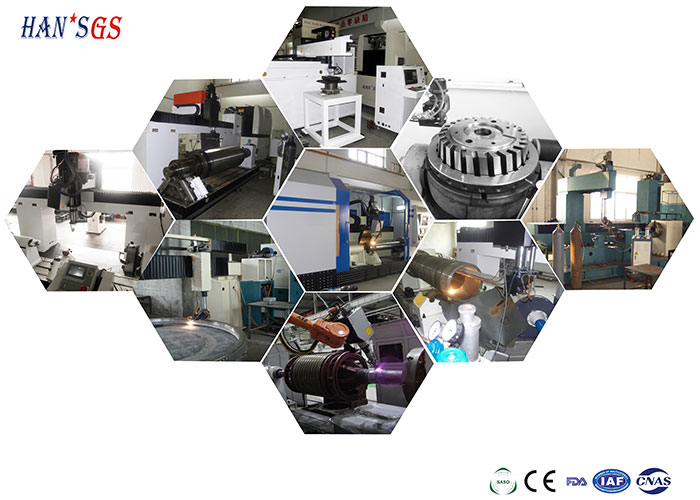Laser cladding of high hardness, wear-resistant and high temperature coating
In order to prevent parts from being damaged due to partial surface damage under high speed, high temperature, high pressure and corrosive environment, and improve the service life of parts, countries in the world are committed to developing various technologies to improve the surface properties of parts. The traditional surface modification technology (such as spraying, spray plating, surfacing and so on) is not ideal because of the poor interlayer bonding force and the limit of the solid diffusion difference. The appearance of high power laser and wide-band scanning device provides a new effective means for material surface modification. Laser cladding is a new surface modification technology with high economic efficiency. It can produce high performance cladding layer on cheap and low performance substrates, thereby reducing material costs, saving valuable rare metals and improving the service life of metal parts.

In modern aircraft manufacturing, titanium alloys and aluminum alloys are widely used. For example, the fourth generation fighter F-22 of the US has reached 41% of the body titanium alloy, while the amount of the advanced V2500 engine titanium alloy has reached 30%. Titanium and titanium alloy with high specific strength, excellent corrosion resistance, good heat resistance, can reduce body weight, improve performance. The defects of titanium alloys are low hardness and poor wear resistance. The hardness of pure titanium is 150 ~ 200HV, and the titanium alloy is usually not more than 350HV. In many cases, due to the formation of a dense oxide film on the surface of titanium and titanium alloy, it will play a role of anti-corrosion. However, when the oxide film ruptures, the environment is bad or crevice corrosion occurs, the corrosion resistance of titanium alloy will be greatly reduced.
In 2000, the total amount of aluminum alloy used for the first flight of American F-35 aircraft was over 30%. But the strength of aluminum alloy is not high enough, and it is easy to produce plastic deformation when used, especially the low hardness and poor wear resistance of aluminum alloy, which restricts its application to some extent.
The microhardness of the surface of the titanium alloy by laser cladding is 800-3000HV. The surface enhancement of aluminum alloy surface by laser cladding is an effective method to solve the problems of poor wear resistance and plastic deformation on the surface of aluminum alloy. Compared with other surface strengthening methods, the method has metallurgical bonding characteristics between the reinforced layer and the aluminum matrix, and the bonding strength is high. The thickness of cladding layer is up to 1 ~ 3mm, and the microstructure is very small. The cladding layer has high hardness and good wear resistance, and has strong bearing capacity, so as to avoid cracks produced by the incompatibility between the soft matrix and the strengthened layer. In addition, the high performance ceramic coating on the surface of titanium alloy and aluminum alloy can be greatly improved with the wear resistance and high temperature resistance of the material.
Thermal barrier coating obtained by laser cladding

In recent years, aviation gas turbine engine to high flow ratio, high thrust weight ratio and high inlet temperature in the direction of the combustion chamber, gas temperature and gas pressure increasing, such as military aircraft engine turbine inlet temperature has reached 1800 degrees Celsius, the temperature of the combustion chamber to reach 2000 to 2200 DEG C, so the high temperature has exceeded the existing high temperature alloy the melting point of. In addition to improving the cooling technology, the preparation of thermal barrier coatings made on the surface of high temperature alloy hot end components (Thermal Bamer Coating, TBCs) is very effective, it can reach 1700 DEG C or higher insulation effect, to meet the high performance of the engine should reduce the service force and material requirements of stability induced by temperature gradient and heat. In 1970s, ceramic thermal barrier coatings (TBCs) were successfully applied to J-75 gas turbine blades. Many countries in the world invested huge amounts of money to research their materials from materials to fabrication processes.

Since 1980s, laser cladding ceramic layer on material surface has obtained dense columnar crystal structure and increased strain tolerance. Dense and uniform laser remelting microstructure and lower porosity can reduce the oxidation rate of the adhesive layer and prevent the penetration of corrosive medium. A high-power laser can be used to directly radiate ceramic or metal powder, melt it and form metallurgical bonding on the metal surface to obtain columnar crystal structure perpendicular to the surface. Because the order of solidification of the cladding layer is relatively small from the surface to the inside, so the structure is conducive to mitigate the thermal stress. For example, 8% (mass fraction) yttria partial stabilized zirconia (YPSZ) thermal barrier coating is obtained by laser cladding. Can also be placed in a uniform matrix mixed powder, mixed powder by high power laser radiation, the formation of molten pool by adjusting the laser power, spot size and scanning speed of the powder melting is good, and on this basis further by changing the composition into the molten pool constantly adding alloy powder, repeating the above process can obtain the gradient coating.
Laser cladding super abrasive and corrosion resistant alloy on the surface of key components can improve the service life of components and shorten the manufacturing cycle when the parts are not deformed. The thermal barrier coating produced by laser cladding has good thermal insulation effect, which can meet the requirements of high performance aero engine to reduce temperature gradient, thermal induced stress and service stability of matrix materials.


 中文
中文 English
English France
France العربية
العربية русский
русский español
español português
português srpski језик
srpski језик Việt Nam
Việt Nam
 中文
中文 English
English France
France العربية
العربية русский
русский español
español português
português srpski језик
srpski језик Việt Nam
Việt Nam







